The Builders Association
introductory notes on site, place and the electronic network from MASTER BUILDER (1994) to CONTINUOUS CITY (2008-)
1: architecture and the electronic network
To exist, is to exist in situ, here and now, hic et nunc. This is precisely what is being threatened by cyberspace and instantaneous, globalized information flows. (Virilio 1995)
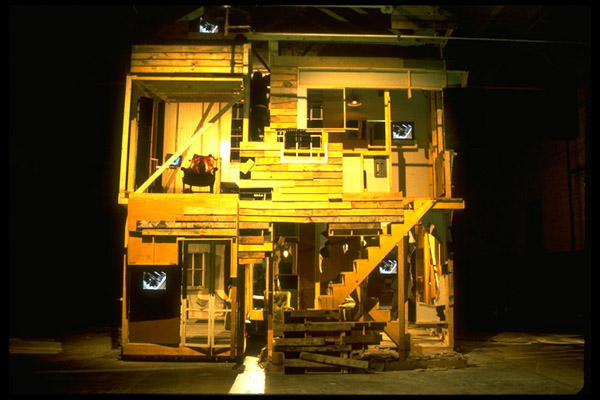
MASTER BUILDER (1994)
The Builders Association’s work begins implicitly with questions of site and presence.
In this context, and while radically different in form, The Builders Association's current project in development, CONTINUOUS CITY (2008-) brings forward concerns underlying their work as a whole. Amongst these is an engagement with architectural concepts linked to core aspects of the company’s aesthetic, and which are reflected in their earliest work. Drawing in conception on the architectural deconstructions of the artist Gordon Matta-Clark , the company’s first production, MASTER BUILDER (1994), set a ‘three-storey house’ onstage, in which Weems embedded a treatment of Ibsen’s The Master Builder.
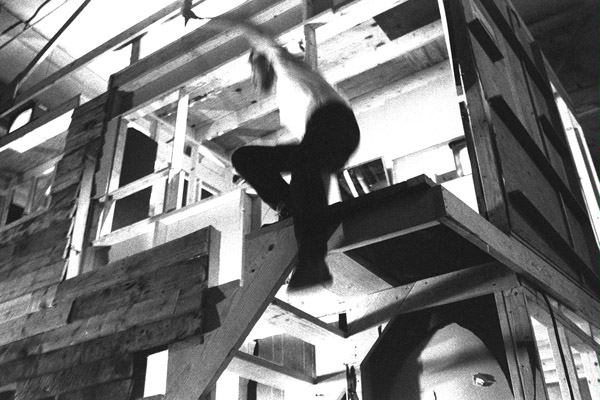
MASTER BUILDER (1994).
In this production, in collaboration with the architect John Cleater, Weems’ responded to concerns in Matta-Clark’s practices, and evident across contemporary ‘theoretical’ architectural projects by artists such as Vito Acconci , and architects such as Bernard Tschumi , Peter Eisenman and others, that, she recalls, ‘had very little to do with actual buildings and much more to do with bodies and the perception and manipulation of space and how space is a system that is ideologically configured’ (Weems, Presence Project/SUPER VISION interview at [link]).
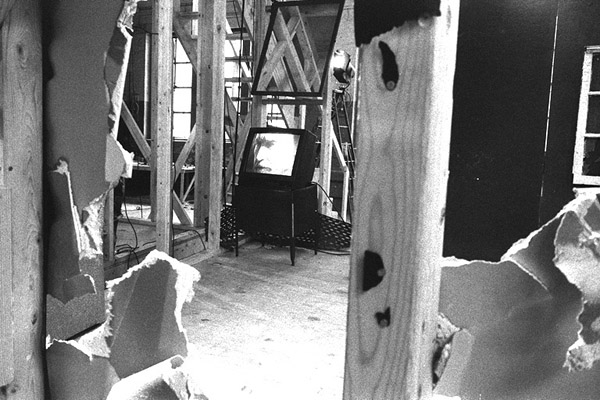
MASTER BUILDER (1994)
In significant ways, the design of MASTER BUILDER drew on Matta-Clark’s material and conceptual interventions into the fabric of existing architectural sites and buildings. In his various performed and sculpted interventions into existing architectural sites, including BRONX FLOORS: THRESHOLE (1972), SPLITTING (1974), and CONICAL INTERSECT (1975), which were subsequently exhibited as film and photographic images akin to contemporary performance documentation and conceptual art, Matta Clark’s interruptions of the stability and orderliness of built forms pressed toward the irruption of apparently ‘negative’ ‘empty,’ seemingly ‘intangible’ and yet paradoxically ‘real’ spaces into the unity of architectural design.
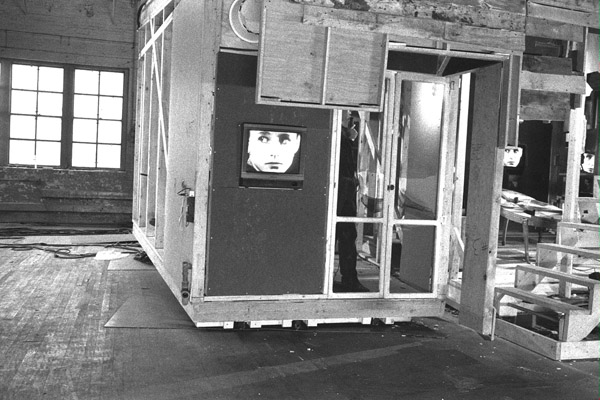
MASTER BUILDER (1994)
The performance of MASTER BUILDER similarly extended to the physical reconstruction of the ‘house’ itself: to the interruption, opening and reconfiguration of the building, even to the splitting of the entire building in half, as well as to the creation of an architectural installation to be exhibited in its own right between performances.
In the course of this production, Weems’ established a key point of departure for the company’s future work. Of MASTER BUILDER, Weems notes:
'It was a dream-like, super-voyeuristic experience. And the house was lined with video and sound triggers, which the actors activated. After that, and in each succeeding project since then, my interest in physical edifices has receded, and what has emerged is the interest in the electronic network and how that too is a kind of architecture.' (Weems, Presence Project/SUPER VISION interview at [link])
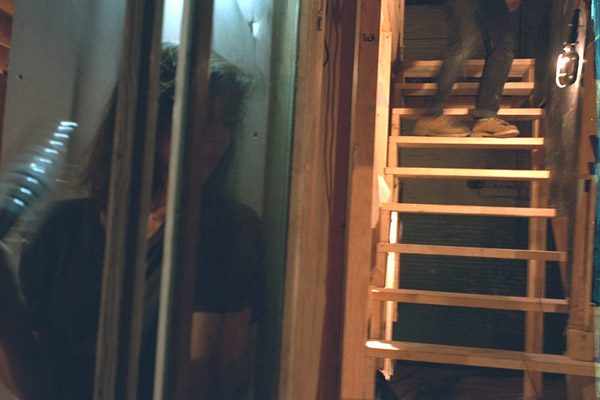
MASTER BUILDER (1994)
In these various aspects, MASTER BUILDER dramatised the performative nature of architectural site, a process extended in the dynamic relationship between performance and installation. On entering the house installation, visitors find themselves occupying the site of the electronic network in which Ibsen’s text has already been enacted. In doing so, the installation announces itself as palimpsest, as a place acted out in the knowledge of its occupation and performance by others.
MASTER BUILDER (1994)
This dynamic also points toward a key theoretical point regarding the performance of place and which is echoed in Weems’ remarks on the architectural sources of The Builders Association’s work.
In The Practice of Everyday Life the philosopher Michel de Certeau reflects on the relationship between ‘place’ and ‘space’. Drawing analogies to the operation of language, de Certeau proposes that: 'space is a practised place. Thus the street geometrically defined by urban planning is transformed into a space by walkers. In the same way, an act of reading is the space produced by the practice of a particular place: a written text' (De Certeau 1984: 117).
Just as no speech act can manifest the complex system of rules on which it depends, so the walker is caught in the act of enunciation, perpetually moving through the practised place, which cannot be resolved into the final, unified order of ‘the city itself.’ Thus, comparing ‘pedestrian processes to linguistic formations,’ de Certeau states categorically that ‘[t]o walk is to lack a place. It is the indefinite process of being absent and in search of a proper’ (de Certeau 1984: 103). For de Certeau, the modern city epitomized this transitory experience of place, producing an awareness of a perpetual performance of place but inability to come to rest in the stability of the ‘proper’. He observes that:
'The moving about that the city multiplies and concentrates makes the city itself an immense social experience of lacking a place […] The identity furnished by this place is all the more symbolic (named) because, in spite of the inequality of its citizens’ positions and profits, there is only a population of passer-by, a network of residences temporarily appropriated by pedestrian traffic, a shuffling among pretences of the proper, a universe of rented spaces haunted by a nowhere or by dreamed-of places.' (De Certeau 1984: 103)
2: media site
‘the more technology seeks to put things in their proper places, the less proper those places turn out to be’ (Weber 1996: 124)
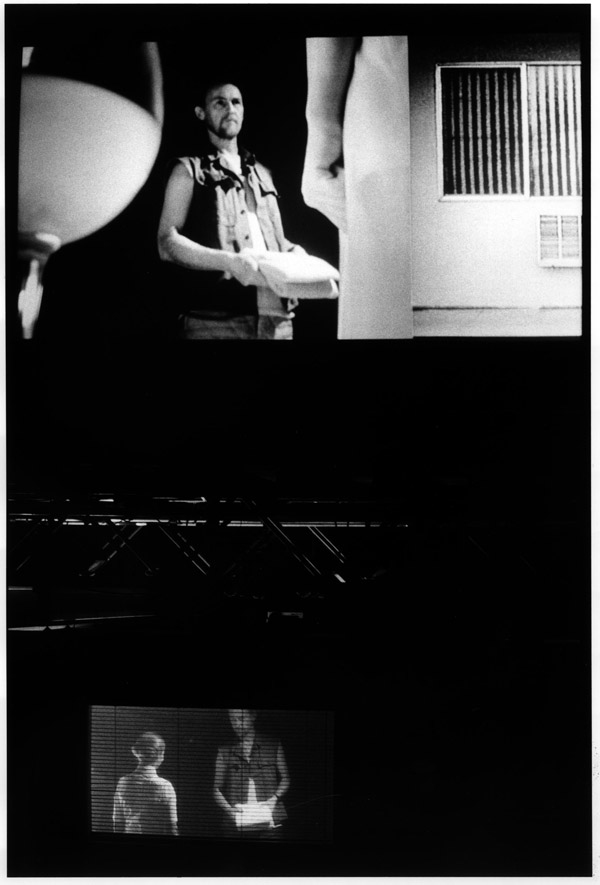
IMPERIAL MOTEL (Faust) (1996)
After de Certeau’s proposition that any spatial practice implies a ‘place,’ a ‘proper’ in which it can never come to rest, the question arises: what is the place implied where architecture and the built environment give way to the ‘electronic network’?
For The Builders Association, the impact of media on site and location forms an explicit part of their engagement with ‘presence’: with ‘being there,’ with the subject’s acting out of real and virtual times and spaces.
In this context, the performance of the electronic network implies a multiplication of places and a fluidity or mobility in place itself.
Following MASTER BUILDER, the company’s subsequent productions IMPERIAL MOTEL (Faust) (1996) and JUMP CUT (Faust) (1997) realised texts by the writer and director John Jesurun through explicit juxtapositions between cinematic and stage spaces. In these projects, the company emphasized the juxtaposition, transposition and passage between live and mediated performance through overt divisions of the stage between theatrical (live) and cinematic (projected) spaces.
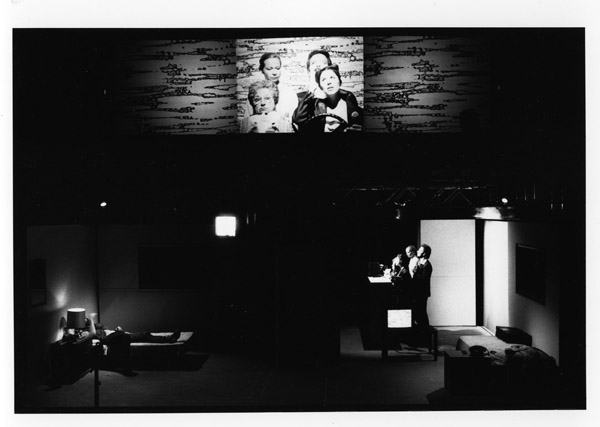
IMPERIAL MOTEL (Faust) (1996)
For IMPERIAL MOTEL (Faust), the company set a large video screen, some six feet high and 18 feet wide, above the main theatrical space and behind a gantry permitting live performers to stand before its projections. In this arrangement, however, the performance exposes the mechanisms by which images are composited or the screen illusion effected.
These practices reflect, in direct theatrical terms, the impact of the electronic network on location, explicitly articulating ‘live’ performance in the ambiguities of transmission, in live and electronic passages and returns between places and times. Here, the company’s work can be seen as reflecting the philosopher Samuel Weber’s proposition that the transmitted or mediated image occupies a place that is 'neither fully there nor entirely here. What it sets before us … is therefore split, or rather, it is a split or a separation that camouflages itself by taking the form of a visible image' (Weber 1996: 120)
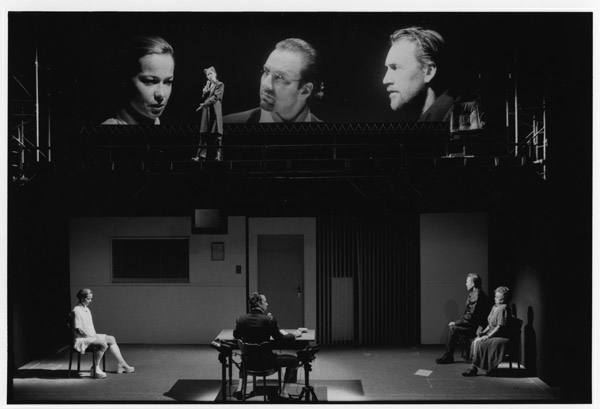
IMPERIAL MOTEL (Faust) (1996)
Echoing this effect, The Builders Association’s practice implicitly contests the ‘proper place’ the performer might occupy, to inscribe into the actor’s performance a movement between places: a movement in place.
Yet, like the operation of the media they employ, The Builders Association’s work also exemplifies the ‘uncanny confusion’ (Weber 1996: 121) Weber ascribes to this transmitted image, in which mediation appears to ‘bring back’ that which it divides: a ‘presentness’ of vision to the object of its mediation; a ‘liveness’ produced in distance, delay and division.
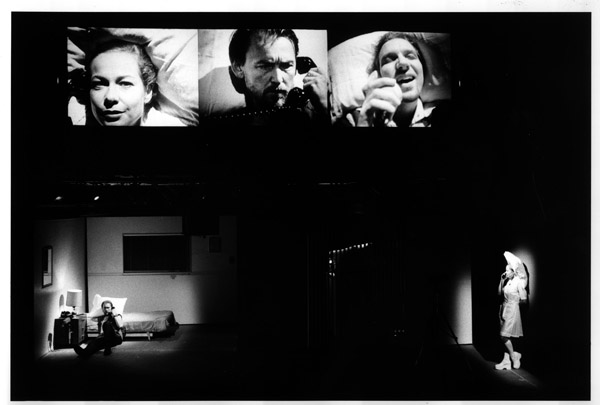
IMPERIAL MOTEL (Faust) (1996)
Here, too, the company’s vocabulary and practice provides a theatrical counterpoint and extension of explorations in video art and video installation. For the artist Vito Acconci, tensions around place and location reach to the core of video installation’s operation. He suggests that:
'Video installation is a conjunction of opposites […] On the one hand, ‘installation’ places an art-work in a specific site, for a specific time (a specific duration and also, possibly, for a specific historical time). On the other hand, ‘video’ (with its consequences followed through: video on broadcast television) is placeless: at least, its place can’t be determined […] Video installation, then, places placelessness.' (Acconci 2001: 376)
In this development, and following IMPERIAL MOTEL (FAUST) and JUMP CUT (FAUST), JET LAG (1999) marked a key departure, setting tensions between place and placelessness thematically at the fore of the company’s work.
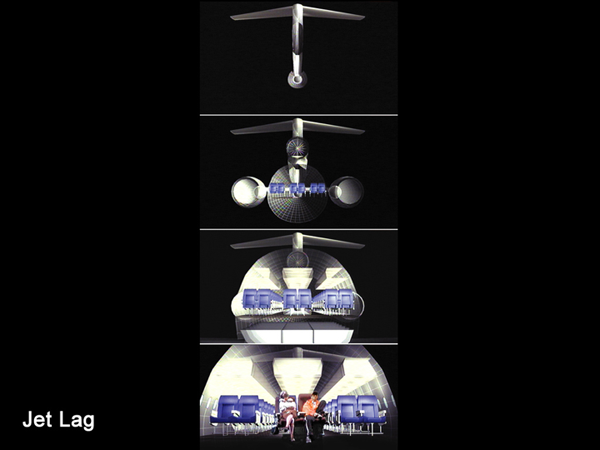
JET LAG (1998)
Created in collaboration with the architectural partnership Diller + Scofidio, JET LAG offers two narratives of contemporary place. Rooted in ‘real’ events, the piece, Elizabeth Diller and Ric Scofidio recall, arose in response to a citation by Paul Virilio:
'He spoke of a ‘great American heroine’ […] who kidnapped her 14-year old grandson and traveled with him from New York to Amsterdam, then Amsterdam to New York, back and forth 167 times over a period of six months in the attempt to elude pursuit by the boy’s father. The father wanted his son to see a psychiatrist. After six months of continuous air travel, the grandmother finally died of ‘jet lag’.' (Diller + Scofidio in Chalmers 1999: 57).
Where this journey, they suggest, ‘simulated domesticity for her grandson while in perpetual motion,’ JET LAG’s other narrative mirrors this in reverse, through a protagonist who ‘fabricated the bravado of movement while in constant stasis’ (Diller + Scofidio in Chalmers 1999: 57).
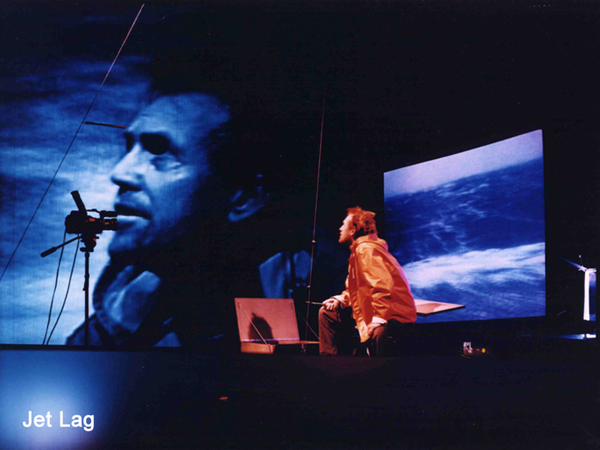
JET LAG (1998)
Diller and Scofidio continue:
'A British sailor (who Jessica Chalmers renamed Roger Dearborn) joined a round-the-world yacht race. Dearborn was so driven by the promise of media attention that he entered the race ill-prepared. The sailor ultimately took two journeys. One took place only in the media: Dearborn sent radio signals falsifying his whereabouts as if he were actually circumnavigating; the other was his actual journey, which consisted of sailing in circles for six months in the South Atlantic, unable to admit his failure. He ultimately died, possibly a suicide by drowning.' (Diller + Scofidio in Chalmers 1999: 57)
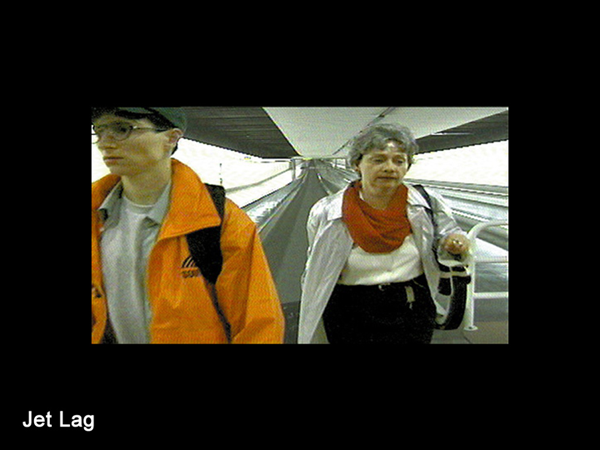
JET LAG (1998)
These stories articulate paradoxical movements in place. Thus, the grandmother’s constant traveling is subject to a ‘deferred time’ (Chalmers 1999: 60) and place produced, Diller and Scofidio suggest, in ‘the boredom of the airport space, which is neither here nor there’ (Diller + Scofidio in Chalmers 1999: 58) . In parallel, Dearborn simulates a powerful narrative of his journey though ‘real space’, a terrain that, for him, lacks all co-ordinate. In these stories, the company focuses on the powerful metaphorical charge of ‘real’ and ‘virtual’ places of passage and transit, which may be characterized after the anthropologist Marc Augé’s account of contemporary ‘non-place’. Formed in the mobility of its users as a passing over of ‘places’ ‘non-place’ is produced, Augé suggests, in ‘a sort of negative quality of place, an absence of the place from itself’ . It is a process and experience amplified in the eclipse of distance effected in the speed of contemporary communications; a dislocation amplified in the increasing and apparent availability and familiarity of places unknown and never visited. In JET LAG, ‘non-place’ is invoked in the media’s capacity to bring closer places, objects and stories, whose production in the media, and so absence from place, is explicit. In turn, to perform the place of the mediatic system is to become subject to this mobility and displacement even under the camouflage or illusion of ‘being there’; of presence.
3: spaces between
‘Increasingly, the architectures of physical space and cyberspace – of the specifically situated body and of its fluid electronic extensions – are superimposed, intertwined, and hybridised in complex ways. The classical unities of architectural space and experience have shattered -’ (Mitchell 1999: 44)
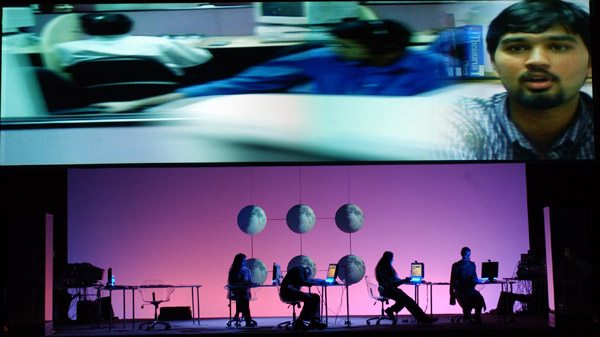
ALLADEEN (2003-5)
Extending this dynamic between ‘place’ and ‘placelessness,’ the company’s more recent work has addressed the individual as agent within this contemporary mediascape; exploring and enacting meanings of being there in real world networked time and place.
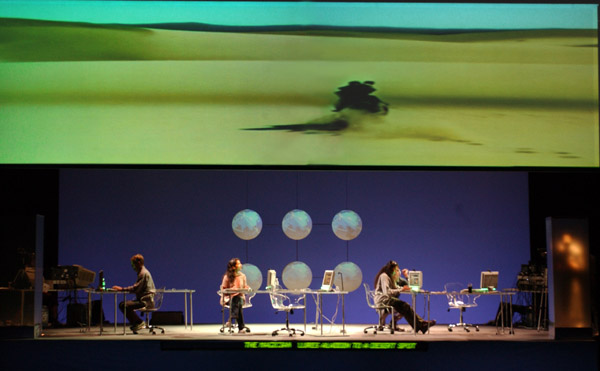
ALLADEEN (2003-5)
In their collaboration with the London-based company motiroti for ALLADEEN (2003-5), the performance of mediated, and so multiple places and times was explored through the experiences of call centre operators working from the Indian sub-continent to the United States.
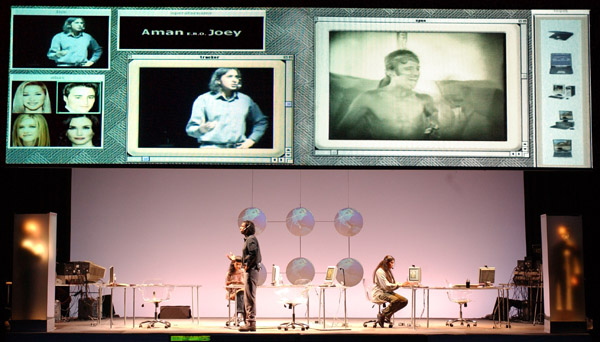
ALLADEEN (2003-5)
To this end, ALLADEEN exposes its own processes of mediation: performers located live onstage are simultaneously re-presented in the diverse mediatic spaces above, in explorations of the ubiquity of media images, the erasure of distance in contemporary communications, and its impact on performed and perceived places and identities. Foregrounding the contradictions of ‘performing American’ - an identity realised in the media’s capacity to synthesize, to camouflage the diverse places of its performance - ALLADEEN narrates the suppression and return – in the media itself - of ‘local’ identity, geography, and politics.
In this context, too, ALLADEEN demonstrates the imperative of the theatrical within this media-based work, of what is at stake in the live performance of media processes. Here, the theatre reasserts the particularity, the resistance, the specificity of body and site, in order to articulate and examine its transformation in the global electronic network.
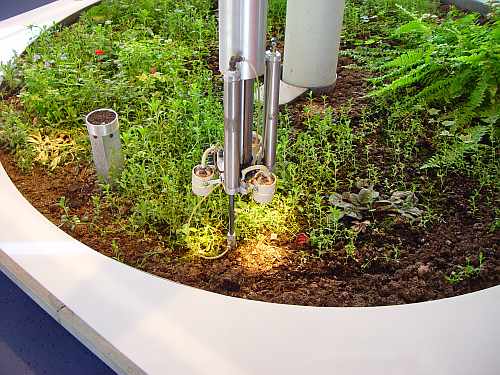
SUPER VISION (2005-6). Image by dbox.
In The Builders Association’s most recently completed project, SUPER VISION (2005-6) this integration of the performer into exchanges between ‘real’ and ‘electronic' spaces achieved a further synthesis.
Developed through the company’s close collaboration with the design and media studio dbox, SUPER VISION combines virtual sets, created in multiple and transforming high-definition projections, with live, mediated and recorded performance, as well as the real time performance of its soundscape and supporting technologies. Here, SUPER VISION’s design and realisation exemplifies media as architecture and site, while performers are embedded in and perform through the flow between theatrical, mediated and recorded spaces.
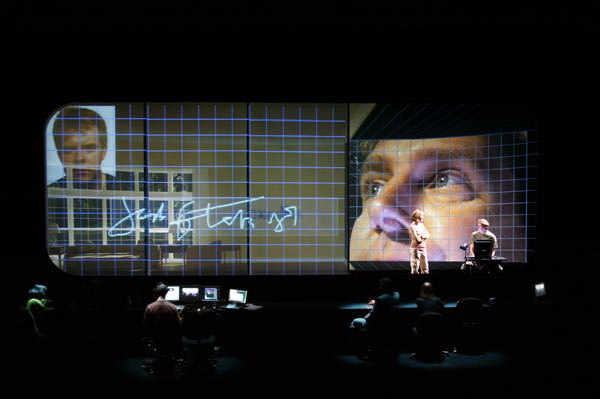
SUPER VISION (2005-6). Photo by dbox.
Interweaving three thematically related narratives, through a text developed in collaboration with Constance DeJong, SUPER VISION engages with identity theft, ‘dataveillance,’ with virtual and ‘natural’ place, and with dispersals of subjectivity and identity. The three narratives are:
'1. A father covertly exploits his young son’s personal data to meet the demands of the family’s lifestyle. This ploy escalates beyond the father's control, until he is compelled to disappear.
2. As he crosses successive borders, a solitary traveller gradually is forced to reveal all of his personal information, until his identity becomes transparent, with no part of his life left outside the boundaries of datasurveillance.
3. A young woman, addicted to the white noise of constant connection, maintains a long-distance relationship with her Grandmother.'
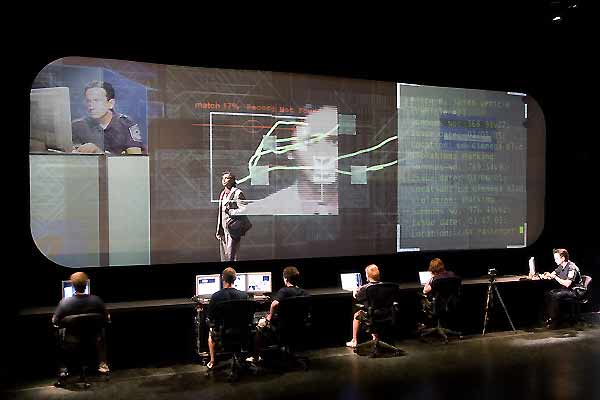
SUPER VISION (2005-6). Photo by dbox.
In SUPER VISION’s elision of oppositions between screen and stage space, the occupation and performance of place cannot be readily assigned to either the signifiers of the live, or the projection toward remote or removed cinematic places and spaces elsewhere.
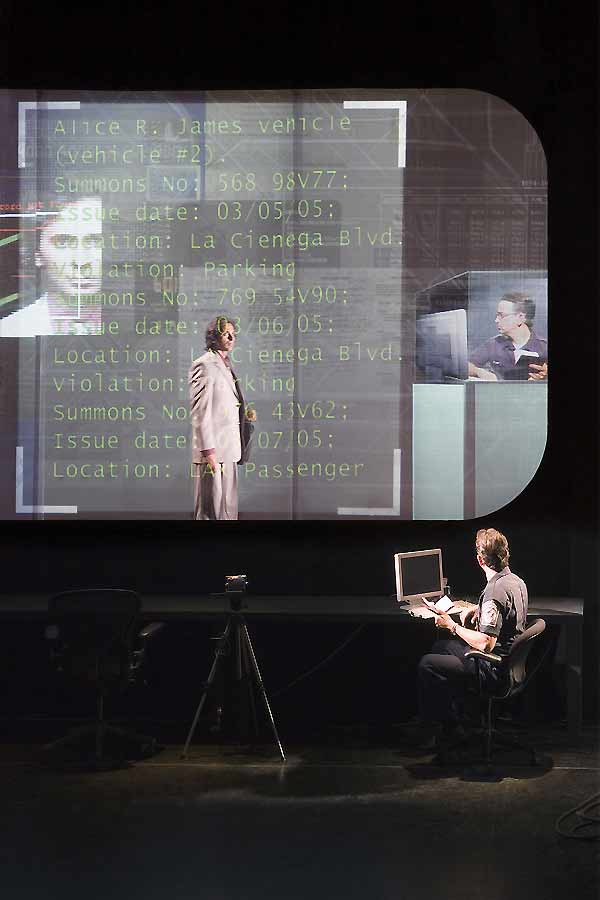
SUPER VISION (2005-6). Photo by dbox.
Onstage, in this place, the company perform ‘live presence’ in and against its ‘screening’. On screen, in ‘real time’ ‘live’ mediation, SUPER VISION takes its cue from and provokes performance onstage.
Amplifying this exchange, overlaying and flow of the real and electronic, many of SUPER VISION’s performers, including here Joe Silovsky (the TSA agent), perform simultaneously toward ‘live’ and ‘mediated’ frames and spaces, provoking an awareness and perception of their actions and presence there (onstage) and here (in projection; in the ‘mediatic’ system).
Furthermore, in SUPER VISION this performance of ‘spaces between’ brings the mediated and recorded forward toward a claim to ‘real’ space and ‘present’ time.
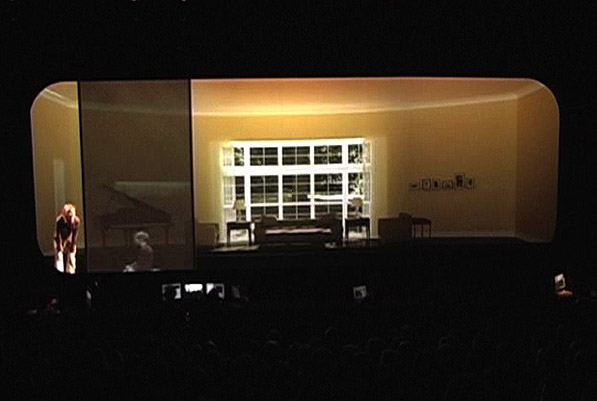
SUPER VISION (2005-6). Video grab.
Thus, in the family scenes, behaviour toward the virtual boy becomes the fulcrum of the family dynamic and the motor to the father’s departure. The presence of the virtual boy, whose projection on the mobile fore-screen renders his image translucent, is articulated in the rhythms of the performers with whom he apparently interacts. In recording, the boy’s ‘performance’ captures a sense of spontaneity and unity; a ‘presentness’ reinvented by his co-performers. In contrast, the father’s performance is seen simultaneously onstage and in ‘live’ mediation, and so in an explicit division of his present-tense performance.
To see this scene from SUPER VISION, link to video streaming:
Family Scene 2
Place, too, is expressed in this integration and reversal.
In its penultimate scene, SUPER VISION reveals John Fletcher Sr., now set against the backdrop of the Arctic having left the family. Echoing references in the first family scenes, a flock of birds appear in the distance, slowly gathering and moving toward the still figure of the father.
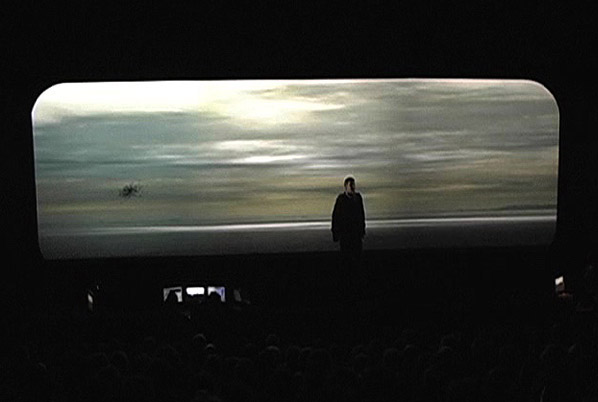
SUPER VISION (2005-6). Video grab
Traveling north to escape the datasphere, to occupy a ‘real’ place, the appearance of the flock of birds in the distance, then coming closer, relates, visually, to the mobile images of data that link and overlap scenes, providing a principal visual motif throughout the performance.
To see this scene from SUPER VISION, link to video streaming:
Here, the web of virtual imagery, the web environment, the data environment constitute the place of departure and arrival. The birds appear, and then they are gone. This place ‘is’ information, code, data, media.
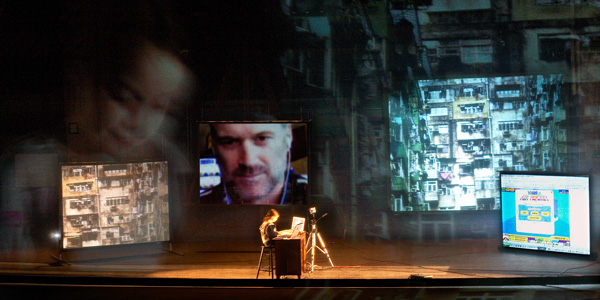
Work in progress, Krannert Centre, University of Illinois in Champaign-Urbana, July 2007.
Where SUPER VISION describes the occupation of a place whose fabric is always already contaminated by the datasphere, CONTINUOUS CITY suggests a ‘place’ defined in multiple virtual architectures: in architectures of signs and desires, of individual narratives formed and reformed in the malleability of WEB 2.0. Here, the spatial dynamic between live and electronic presence evident in The Builders Association’s work is extended out toward the audience and participants as chorus. In the CONTINUOUS CITY the interactive electronic network is a primary architecture of contemporary place and experience: a place defined and occupied in an awareness of the simultaneous performance of diverse acts of location; of collocations of performances, of virtual cities, of de Certeau’s ‘dreamed-of places,’ written and seen through each other.
Images and video by kind permission of The Builders Association
For our evolving documentation of the making of CONTINUOUS CITY (2008-), please go to [link] or for the Presence Project's engagement with SUPER VISION (2005-6), follow [link]
For further discussion of The Builders Association's work by Nick Kaye, see 'Screening Presence: The Builders Association and dbox, SUPER VISION (2005)', Contemporary Theatre Review 17:4, 2007, pp555-575 and Multi-Media: video - installation - performance, Routledge, 2007, London & New York.
I am grateful to Marianne Weems and Shannon Jackson for the opportunity to present this paper at the Continuous Bodies: Performance, Space, Technology, UC Berkeley, October 2007.
Back to The Builders Association
References





















